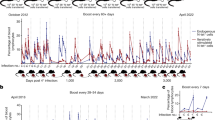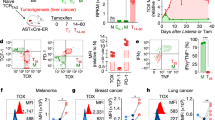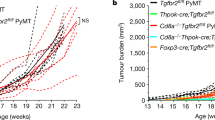Abstract
Cancer control by adaptive immunity involves a number of defined death1,2,3,4,5,6,7,8 and clearance9,10,11 mechanisms. However, efficient inhibition of exponential cancer growth by T cells and interferon-γ (IFN-γ) requires additional undefined mechanisms that arrest cancer cell proliferation1,2,3,4,5,12,13. Here we show that the combined action of the T-helper-1-cell cytokines IFN-γ and tumour necrosis factor (TNF) directly induces permanent growth arrest in cancers. To safely separate senescence induced by tumour immunity from oncogene-induced senescence9,10,11,14,15,16,17, we used a mouse model in which the Simian virus 40 large T antigen (Tag) expressed under the control of the rat insulin promoter creates tumours by attenuating p53- and Rb-mediated cell cycle control18,19. When combined, IFN-γ and TNF drive Tag-expressing cancers into senescence by inducing permanent growth arrest in G1/G0, activation of p16INK4a (also known as CDKN2A), and downstream Rb hypophosphorylation at serine 795. This cytokine-induced senescence strictly requires STAT1 and TNFR1 (also known as TNFRSF1A) signalling in addition to p16INK4a. In vivo, Tag-specific T-helper 1 cells permanently arrest Tag-expressing cancers by inducing IFN-γ- and TNFR1-dependent senescence. Conversely, Tnfr1−/−Tag-expressing cancers resist cytokine-induced senescence and grow aggressively, even in TNFR1-expressing hosts. Finally, as IFN-γ and TNF induce senescence in numerous murine and human cancers, this may be a general mechanism for arresting cancer progression.
This is a preview of subscription content, access via your institution
Access options
Subscribe to this journal
Receive 51 print issues and online access
$199.00 per year
only $3.90 per issue
Buy this article
- Purchase on Springer Link
- Instant access to full article PDF
Prices may be subject to local taxes which are calculated during checkout




Similar content being viewed by others
References
Finn, O. J. Cancer immunology. N. Engl. J. Med. 358, 2704–2715 (2008)
Hanahan, D. & Weinberg, R. A. Hallmarks of cancer: the next generation. Cell 144, 646–674 (2011)
Schreiber, R. D., Old, L. J. & Smyth, M. J. Cancer immunoediting: integrating immunity’s roles in cancer suppression and promotion. Science 331, 1565–1570 (2011)
Koebel, C. M. et al. Adaptive immunity maintains occult cancer in an equilibrium state. Nature 450, 903–907 (2007)
van den Broek, M. E. et al. Decreased tumor surveillance in perforin-deficient mice. J. Exp. Med. 184, 1781–1790 (1996)
Willimsky, G. & Blankenstein, T. Sporadic immunogenic tumours avoid destruction by inducing T-cell tolerance. Nature 437, 141–146 (2005)
Mocikat, R. et al. Natural killer cells activated by MHC class ILow targets prime dendritic cells to induce protective CD8 T cell responses. Immunity 19, 561–569 (2003)
Hung, K. et al. The central role of CD4+ T cells in the antitumor immune response. J. Exp. Med. 188, 2357–2368 (1998)
Xue, W. et al. Senescence and tumour clearance is triggered by p53 restoration in murine liver carcinomas. Nature 445, 656–660 (2007)
Rakhra, K. et al. CD4+ T cells contribute to the remodeling of the microenvironment required for sustained tumor regression upon oncogene inactivation. Cancer Cell 18, 485–498 (2010)
Kang, T. W. et al. Senescence surveillance of pre-malignant hepatocytes limits liver cancer development. Nature 479, 547–551 (2011)
Müller-Hermelink, N. et al. TNFR1 signaling and IFN-γ signaling determine whether T cells induce tumor dormancy or promote multistage carcinogenesis. Cancer Cell 13, 507–518 (2008)
Röcken, M. Early tumor dissemination, but late metastasis: insights into tumor dormancy. J. Clin. Invest. 120, 1800–1803 (2010)
Braig, M. et al. Oncogene-induced senescence as an initial barrier in lymphoma development. Nature 436, 660–665 (2005)
Campisi, J. & d’Adda di Fagagna, F. Cellular senescence: when bad things happen to good cells. Nature Rev. Mol. Cell Biol. 8, 729–740 (2007)
Collado, M. & Serrano, M. Senescence in tumours: evidence from mice and humans. Nature Rev. Cancer 10, 51–57 (2010)
Nardella, C., Clohessy, J. G., Alimonti, A. & Pandolfi, P. P. Pro-senescence therapy for cancer treatment. Nature Rev. Cancer 11, 503–511 (2011)
Bergers, G., Javaherian, K., Lo, K. M., Folkman, J. & Hanahan, D. Effects of angiogenesis inhibitors on multistage carcinogenesis in mice. Science 284, 808–812 (1999)
Casanovas, O., Hager, J. H., Chun, M. G. & Hanahan, D. Incomplete inhibition of the Rb tumor suppressor pathway in the context of inactivated p53 is sufficient for pancreatic islet tumorigenesis. Oncogene 24, 6597–6604 (2005)
Hunder, N. N. et al. Treatment of metastatic melanoma with autologous CD4+ T cells against NY-ESO-1. N. Engl. J. Med. 358, 2698–2703 (2008)
Kenter, G. G. et al. Vaccination against HPV-16 oncoproteins for vulvar intraepithelial neoplasia. N. Engl. J. Med. 361, 1838–1847 (2009)
Hodi, F. S. et al. Improved survival with ipilimumab in patients with metastatic melanoma. N. Engl. J. Med. 363, 711–723 (2010)
Schwartzentruber, D. J. et al. gp100 peptide vaccine and interleukin-2 in patients with advanced melanoma. N. Engl. J. Med. 364, 2119–2127 (2011)
Morgan, R. A. et al. Cancer regression in patients after transfer of genetically engineered lymphocytes. Science 314, 126–129 (2006)
Canova, C. et al. Genetic associations of 115 polymorphisms with cancers of the upper aerodigestive tract across 10 European countries: the ARCAGE project. Cancer Res. 69, 2956–2965 (2009)
Critchley-Thorne, R. J. et al. Impaired interferon signaling is a common immune defect in human cancer. Proc. Natl Acad. Sci. USA 106, 9010–9015 (2009)
Zhang, B., Karrison, T., Rowley, D. A. & Schreiber, H. IFN-γ- and TNF-dependent bystander eradication of antigen-loss variants in established mouse cancers. J. Clin. Invest. 118, 1398–1404 (2008)
Gurzov, E. N. et al. Pancreatic β-cells activate a JunB/ATF3-dependent survival pathway during inflammation. Oncogene 31, 1723–1732 (2012)
Kuilman, T. et al. Oncogene-induced senescence relayed by an interleukin-dependent inflammatory network. Cell 133, 1019–1031 (2008)
Acosta, J. C. et al. Chemokine signaling via the CXCR2 receptor reinforces senescence. Cell 133, 1006–1018 (2008)
Hanahan, D. Heritable formation of pancreatic β-cell tumours in transgenic mice expressing recombinant insulin/simian virus 40 oncogenes. Nature 315, 115–122 (1985)
Pfeffer, K. et al. Mice deficient for the 55 kd tumor necrosis factor receptor are resistant to endotoxic shock, yet succumb to L. monocytogenes infection. Cell 73, 457–467 (1993)
Förster, I., Hirose, R., Arbeit, J. M., Clausen, B. E. & Hanahan, D. Limited capacity for tolerization of CD4+ T cells specific for a pancreatic β cell neo-antigen. Immunity 2, 573–585 (1995)
Maglione, J. E. et al. Transgenic polyoma middle-T mice model premalignant mammary disease. Cancer Res. 61, 8298–8305 (2001)
Shultz, L. D., Ishikawa, F. & Greiner, D. L. Humanized mice in translational biomedical research. Nature Rev. Immunol. 7, 118–130 (2007)
Ziegler, A. et al. EpCAM, a human tumor-associated antigen promotes Th2 development and tumour immune evasion. Blood 113, 3494–3502 (2009)
Monks, A. et al. Feasibility of a high-flux anticancer drug screen using a diverse panel of cultured human tumor cell lines. J. Natl. Cancer Inst. 83, 757–766 (1991)
Keyes, W. M. et al. p63 deficiency activates a program of cellular senescence and leads to accelerated aging. Genes Dev. 19, 1986–1999 (2005)
Dickins, R. A. et al. Probing tumor phenotypes using stable and regulated synthetic microRNA precursors. Nature Genet. 37, 1289–1295 (2005)
Kneilling, M. et al. Direct crosstalk between mast cell-TNF and TNFR1-expressing endothelia mediates local tissue inflammation. Blood 114, 1696–1706 (2009)
Kunder, S. et al. A comprehensive antibody panel for immunohistochemical analysis of formalin-fixed, paraffin-embedded hematopoietic neoplasms of mice: analysis of mouse specific and human antibodies cross-reactive with murine tissue. Toxicol. Pathol. 35, 366–375 (2007)
Hennige, A. M. et al. Overexpression of kinase-negative protein kinase Cδ in pancreatic β-cells protects mice from diet-induced glucose intolerance and β-cell dysfunction. Diabetes 59, 119–127 (2010)
Biedermann, T. et al. Mast cells control neutrophil recruitment during T cell-mediated delayed-type hypersensitivity reactions through tumor necrosis factor and macrophage inflammatory protein 2. J. Exp. Med. 192, 1441–1452 (2000)
Acknowledgements
The authors thank A. Knuth, H. G. Rammensee, K. Ghoreschi, J. Brück, G. Riethmüller, G. Stingl, T. Biedermann and A. Yazdi for discussions, T. Haug for technical support in the chromium release assay, R. Dummer for melanoma samples, W. Kempf for technical support in the cell cycle analysis and S. Lowe for the p16–p19 shRNA concept. The technical assistance of S. Weidemann and M. Dierstein is gratefully acknowledged. This work is part of the doctoral thesis of E.B., S.A., M.H., K.B., J.Berdel and C.G., and was supported by the Sander Stiftung (2005.043.2 and 2005.043.3), the Deutsche Krebshilfe (No. 109037), the IZKF-Promotionskolleg ‘Molekulare Medizin’ 2010 (1886-0-0), 2011 (PK 2011-3) and 2012 (PK 2012-1), the Deutsche Forschungsgemeinschaft (SFB 685, SFB 773 and Wi 1279/3-1) and in part by the German Federal Ministry of Education and Research (BMBF) to the German Center for Diabetes Research (DzD e.V.).
Author information
Authors and Affiliations
Contributions
M.R. originally developed the concept, further elaborated on it, and designed the experiments together with H.B., T.W., R.M. and K.S.-O. H.B., T.W., S.A., M.K., C.G., F.E., M.H., K.B., T.M. and E.B. performed experiments and analysed the data. B.F. and M.S. established and carried out fluorescence microscopy. L.Q.-M. and F.F. performed light microscopy and advised on cell biology. M.A., K.S. and R.H. supervised and performed the β-cancer-cell-transfer experiments. L.Z. and M.P. generated shp16–p19 MSCV vectors and supervised the knockdown experiments. H.N. and F.M. isolated primary melanoma cells, J.Berdel and J.Bauer collected human melanoma specimen and performed immunohistochemical analysis. F.R., S.U. and H.-U.H. isolated β-cancer cells and advised on β-cell physiology. H.B., T.W., M.v.d.B., K.S.-O. and M.R. interpreted the data and wrote the paper.
Corresponding author
Ethics declarations
Competing interests
The authors declare no competing financial interests.
Supplementary information
Supplementary Information
This fie contains Supplementary Figures 1-16, Supplementary Tables 1-3, a chart showing the clinical and pathological characterization of patients, and a chart showing the sequences for RNA constructs. (PDF 3208 kb)
Rights and permissions
About this article
Cite this article
Braumüller, H., Wieder, T., Brenner, E. et al. T-helper-1-cell cytokines drive cancer into senescence. Nature 494, 361–365 (2013). https://doi.org/10.1038/nature11824
Received:
Accepted:
Published:
Issue Date:
DOI: https://doi.org/10.1038/nature11824
This article is cited by
-
Dormancy of cutaneous melanoma
Cancer Cell International (2024)
-
Immunosurveillance encounters cancer metabolism
EMBO Reports (2024)
-
Natural killer cell therapies
Nature (2024)
-
mTOR inhibition abrogates human mammary stem cells and early breast cancer progression markers
Breast Cancer Research (2023)
-
Aging microenvironment and antitumor immunity for geriatric oncology: the landscape and future implications
Journal of Hematology & Oncology (2023)
Comments
By submitting a comment you agree to abide by our Terms and Community Guidelines. If you find something abusive or that does not comply with our terms or guidelines please flag it as inappropriate.



